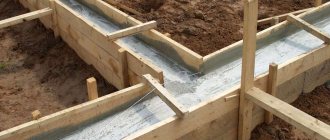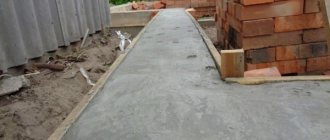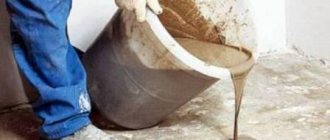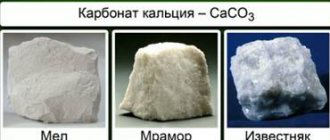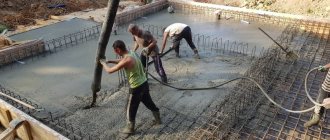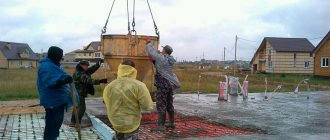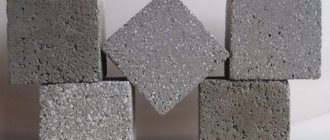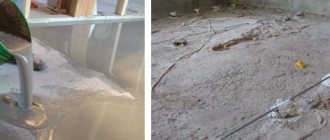After the foundation is poured, it must be properly maintained. Professionals do not question whether it is necessary to water the concrete after pouring - they know that this procedure is mandatory. According to the rules, after installation, further care is required, including periodic moisturizing.
Mixture composition
The components of the mixture are:
- cement (after mixing, it connects the elements of concrete);
- water;
- aggregate (sand, crushed stone or gravel).
It is possible to improve the operational and technical performance of a structure with the help of special additives (mineral or organic).
Beginners do not always understand for what purpose it is necessary to water concrete after pouring, because they do not know the features of this material. The main active components are water and binder, which envelop the aggregate (which is passive in the mixture).
Water plays an important role in cement mortar. It takes part in physical and chemical processes that lead to its neutralization. Gradually, moisture evaporates and the binder hardens. As a result of binding aggregate grains, concrete (durable artificial stone) is obtained from the mixture.
Fillers occupy up to 85% of the total volume. Their properties influence the physical and mechanical properties of concrete. The share of water in the mixture is about 7% of the volume, cement - 13%.
The top layer loses moisture faster (compared to the bottom layer and middle), so cracks may appear in the concrete. When the surface overdries, the strength of the product decreases and the design will not be able to meet the required grade.
Why is watering necessary?
The active ingredients of a concrete mixture are liquid and cement mortar. They envelop the filler. Gradually, the water begins to evaporate and the binder begins to harden. During this process, the filler grains bind together and the liquid mixture becomes a monolith. If the top layer of the composition loses moisture faster than the middle, cracks may form. In addition, if the surface dries out, the product becomes less durable. Thus, the concrete product will not be able to meet the required grade.
Need for hydration
Often, those new to construction pour concrete into the foundation with their own hands and are sure that the work ends there. However, it takes time (up to 4 weeks) for concrete to gain the required strength.
Strength is influenced by ambient temperature and precipitation. Only after this period has expired is it possible to begin building walls (if we are talking about building a house).
The strength gain continues in the future due to the evaporation of moisture (it is necessary that this process be uniform and moisture evaporate from the volume of concrete masonry).
If the ambient temperature is high and a strong wind is blowing, the process of evaporation of water from the outer layer will occur more intensely. And due to rapid drying, depending on its speed, precipitation will occur faster. This causes areas with numerous small cracks to appear on the surface of the structure.
When the hardening process is completed, under the influence of negative environmental conditions, cracks will contribute to the destruction of the concrete structure. In winter, water that gets into cracks freezes and can tear the structure apart.
When the foundation of a building is subjected to such destruction, cracks may appear on the facade, and their size will gradually increase. If the top layer is overdried, the process of cement hydration stops. Because of this, strength is gained slowly and is lower than the planned grade.
To prevent problems from occurring, you should water the concrete regularly until it hardens completely. You need to understand that concrete does not become stronger as a result of moisture. Watering prevents it from becoming brittle.
When the surface is wet during the hardening process, settlement occurs more slowly, the stress on the surface becomes weaker, and the risk of cracks will be minimal.
Possible consequences
In special frosty conditions, you must remember to follow all the rules for winter filling, otherwise irreversible consequences may occur, after which there can be no talk of any further operation of your facility. Therefore, you must strictly take into account all the standards and calculation data of this matter.
If you pour liquid into concrete during frost and do not do it correctly or with some, even minor, violations, then the thermal processes of hydration in the formwork, which proceed and are completed after about three to five days, may stop completely.
This leads to sad consequences; as a rule, the surface layer of your fill will be loose and crumbly. In this case, the work needs to be completely redone.
Maintenance of concrete structures
The main goals of surface care after pouring the foundation:
- reduction of plastic shrinkage;
- increase in strength;
- preventing drying out;
- neutralization of the influence of temperature changes;
- increase in service life;
- preventing the influence of chemical and mechanical forces.
To understand how much concrete needs to be watered, you need to know about the existing rules. Methods of care after pouring the foundation are influenced by:
- type of cement;
- type of construction;
- climatic conditions, etc.
The maintenance period is affected by the hardening speed of the cement in the mixture:
- structures made of cement, which hardens gradually, need to be wetted for 4 weeks;
- structures based on Portland cement - from 2 to 3 weeks;
- on quick-hardening cement - 8 days.
In hot and dry weather, longer maintenance is required. To slow the evaporation of moisture and to protect against overheating after pouring, it is recommended to cover the foundation with moistened sawdust, matting, and roofing felt.
In hot weather or strong winds, it is recommended to start irrigating the surface 2-3 hours after finishing work. Not everyone understands how to water correctly.
If you use a jet with strong pressure to moisturize, the plane that has not had time to harden may become deformed. It is recommended to use a sprayer to create an imitation of rain over the surface.
Watering should be carried out throughout the day so that the structure is constantly wet. You can understand how often you need to irrigate the surface by paying attention to the temperature and humidity of the air.
It matters how much time should pass between waterings. In extreme heat, breaks between moisturizing should not be more than 2 hours, in other cases - every 3 hours during the day, and up to 3 times at night. The appearance of hissing during irrigation indicates an insufficient amount of water.
Requirements for water for irrigation:
- must be clean flowing;
- it should not contain impurities that can have an aggressive effect on the surface;
- groundwater located close to the surface cannot be used;
- recommended pH level = 7 (permissible deviation - 1);
- must not contain pesticides or organic deposits;
- There should not be a large amount of calcium, magnesium, sodium.
On the foundation, which is in the formwork, moisture is retained longer, so irrigation is allowed less often. After removing the formwork, it is necessary to begin watering, paying more attention to the edges of the structure, since they are more susceptible to the influence of wind and temperature, so moisture loss occurs faster.
Sometimes, to preserve moisture, the surface is covered with a polyethylene film. During the evaporation process, water droplets end up on the inside of the film, and some of the moisture returns to the foundation. This technique allows you to reduce the number of waterings, but is not able to replace them completely.
Specifics of autumn filling
Construction in the rainy autumn is not as comfortable as in the summer, when concrete quickly gains strength. But if there is no alternative, you managed to dig a trench before frost, pour the concrete solution in early autumn, then the foundation will have time to acquire the required strength characteristics. By performing the work correctly, you can avoid subsidence of the foundation and subsequent deformation of the building walls.
Let's consider what weather factors determine the quality of work if the foundation is planned to be poured in the fall:
- Temperature regime.
The favorable temperature for setting and hardening of the concrete mixture is considered to be from 3 to 25 degrees Celsius. Elevated temperatures negatively affect strength, and at lower temperatures, hydration occurs worse. Favorable temperatures ensure slow hardening of the concrete solution in the autumn, significantly improving the strength characteristics. It is important to have time to complete the work before the soil freezes, when it swells under the influence of moisture. If a sharp drop in temperature is not expected, then get to work. - Ground water level.
If work is carried out in a swampy area or soil characterized by high humidity, pay attention to this factor. Despite the fact that in the first autumn months, when it does not rain, the level of groundwater layers is low, but the beginning of autumn rains contributes to a rise in the level. In unfavorable conditions, it is not advisable to build a foundation. We'll have to reschedule work until the spring.
If the construction process was carried out incorrectly, there is a risk of subsequent disposal of the foundation due to its unsuitability
Think through everything carefully, take advantage of the autumn period. Is it possible to pour the foundation in the fall? Naturally, remembering the main points:
- the optimal period for pouring is the beginning of autumn, when it is not hot, far from severe frosts or autumn showers;
- Focus on the long-term weather forecast, plan the start of work so that the concrete has time to gain strength within a month. During this period there should be no frosts that turn water into ice, which destroys the foundation;
- the degree of negative impact of precipitation is somewhat exaggerated. 3 days after pouring, they will not be able to cause serious harm to the hardening base, additionally moistening the surface.
While the issue of protection from autumn precipitation is easy to solve, protecting yourself from freezing temperatures is not easy. But this is possible, although the estimated cost of construction activities increases significantly. Let's consider this situation in more detail.
When pouring in the fall, there is no need for additional moisture
Concrete maintenance times
How many days concrete care should continue depends on environmental conditions. If the temperature:
- above +15°C, it takes 7-15 days to moisturize;
- above +10°C, the watering period is reduced to 5-10 days;
- below +5°C, irrigation can be stopped.
Wetting should continue until the structure reaches its design strength of 70%. On average, this takes 10 days. If you pour concrete longer, the effect may be the opposite: due to excess moisture, strength will increase more slowly.
How to water concrete products
To moisten the structure it is recommended:
- use a hose with a sprayer;
- pay more attention to nodes and edges (in such places water evaporates faster, for this reason cracks or chips may occur);
- to prevent evaporation from the surface of a large area, cover it with film;
- distribute water evenly;
- Irrigate the base, in addition to the top layer.
In the first 2 weeks, the surface should be constantly wet; watering should be done regularly, not allowing the moisture to evaporate completely. If the surface is not moistened, premature dehydration occurs and the fragility of the material increases.
Freeze protection methods
If the foundation must inevitably be poured in the fall, be sure to use one of the following methods to prevent the mortar from freezing while curing:
- The use of anti-frost additives allowing concrete to achieve the required strength at temperatures down to -20 ° C. The negative point is a significant increase in the cost of construction, which does not allow using the technique for arranging large foundations.
- The use of electrical heating of concrete with a special heat cable laid over the surface and covered with insulation. The method of passing voltage with high current is effective, but expensive, given the high cost of energy.
- Covering the base with sheets of polystyrene foam, tyrsa, mineral wool, film or any heat-insulating materials. An inexpensive, justified method of protection that allows the slowly cooling composition to retain heat throughout the week and provide a comfortable setting.
- Installation of thermal formwork. Carried out by specialized construction companies. This is an expensive but effective method that allows you to increase the temperature of the massif to + 30 ° C and maintain it throughout the setting period.
Of course, it is best to complete the work before the onset of cold weather. If you build in September, then laying the foundation will not lead to additional costs. The closer to winter, the greater the likelihood of problematic situations.
An advantage for laying a foundation in the fall compared to summer is the groundwater level, which is often significantly lower than in the summer
Do not forget that the hardening period of concrete is 28 days. If concreting is delayed, the foundation will need to be protected from negative temperatures for a whole month. Are you ready for this?

